Build an effective plan to reduce addiction and overdose in your construction business.

State-level studies have found that construction workers are six to seven times more likely to die from an opioid overdose than workers in other professions.
The physical demands of construction jobs are unavoidable. Pain, injury, and disability can lead to addiction and overdose. The loss of lives — not to mention the costs associated with the loss of safety, productivity, and retention — mandate a plan of action.
Jason Tull’s story
Drug overdoses are on the rise.
The top two industries for men who died of a drug overdose were the construction and the installation, maintenance, and repair industries.1
From 2011 to 2018, construction workers who died at work due to unintentional overdose increased about nine times, more than double the growth in all other industries.2
Nearly half of the overdose fatalities on construction job sites were caused by nonmedical drugs (47.3%).
According to the Centers for Disease Control and Prevention (CDC), Delaware is second in the nation for the per-capita rate of drug-related overdose deaths.
Opioids in the Construction Industry
Workplaces are paying the price.
Safety
Opioid use is associated with more injuries.
Absenteeism
A loss of 50% more work time.
Loss of productivity
Estimated to cost more than $400 billion.
Lower job retention
Individuals with substance use or opioid use disorders change jobs more frequently than those in the general workforce.
Higher health care spend
Costs are three times higher for those who misuse prescription drugs.
Protect and support your employees with this toolkit.
You play an important role in saving lives through the adoption of workplace policies, training, and practices. This toolkit provides guidance and recommendations to help Delaware construction employers support their employees through prevention, treatment, and recovery from opioid misuse and opioid use disorder (OUD).
Get free Narcan® for your employees.
Narcan overdose reversal medication and Narcan use training are available for free, plus informational sessions on addressing addiction and stigma. Contact OHCR@delaware.gov to get free Narcan and schedule training.
“Toolbox Talks” can be a first step.
Many construction sites already use Toolbox Talks to conduct training on OSHA requirements. This approach can be used to provide training, education, and resources to employees on substance misuse as well. Consider scheduling quarterly substance-related safety talks with the teams on the job site, which can include videos and other educational materials on impairment and substance use and misuse.
Advice for an effective safety Toolbox Talk:
- Keep It Brief — Five to 15 minutes is a suitable amount of time to deliver a message without losing the attention of the audience.
- Stay Focused — Stay on point to effectively deliver your message.
- Be Relevant — Discuss topics that can be helpful to the workers.
- Seek Engagement — Get the workers to prove they are listening by getting them involved (e.g., have them provide examples of the topics being discussed and allow for questions to be asked).
- Get Total Buy-In — Teamwork improves safety, and everyone should be on alert.
The following is a recommendation of topics that touch on substance use and misuse:
- Opioid deaths in the construction industry
- Discussing prescription opioid painkillers with your health care provider
- Employee assistance program
- Understanding opioid pain medication — know the risks
- Common risks at work due to opioid painkiller use
Delaware Construction Industry New Employee Orientation
More info and guidance are available on toolkit fact sheets.
These downloadable fact sheets offer the key information you need to inform, support, and involve your employees in reducing substance use and misuse in your construction business. You will find modules that focus on education about opioids, communications training, naloxone training, drug testing strategies and policies, and much more. We recommend you review all of them and determine the best way to use the modules within your organization.
Download all fact sheets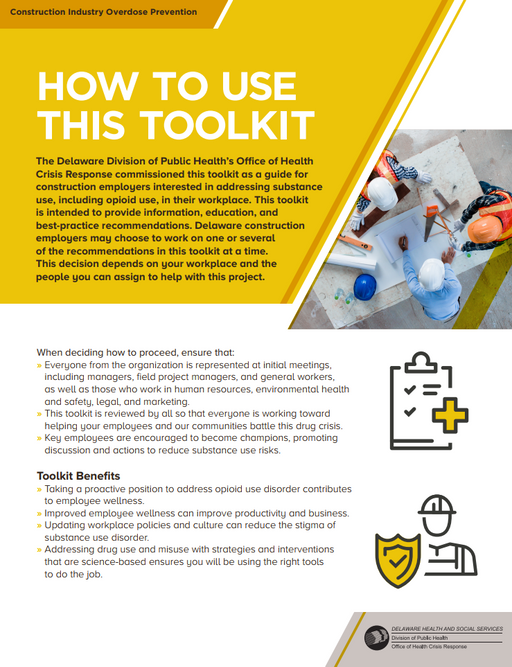
How to Use This Toolkit
- Who should use the toolkit
- Toolkit benefits
- How the toolkit is organized
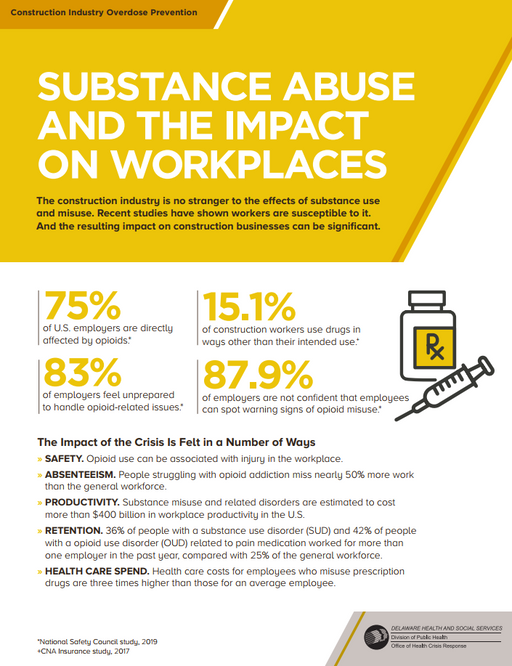
Information About Substance Abuse and How Workplaces Are Impacted
- Addiction 101
- Definition of substance abuse disorder
- How prescription opioids are driving the opioid epidemic
- Symptoms of opioid use disorder
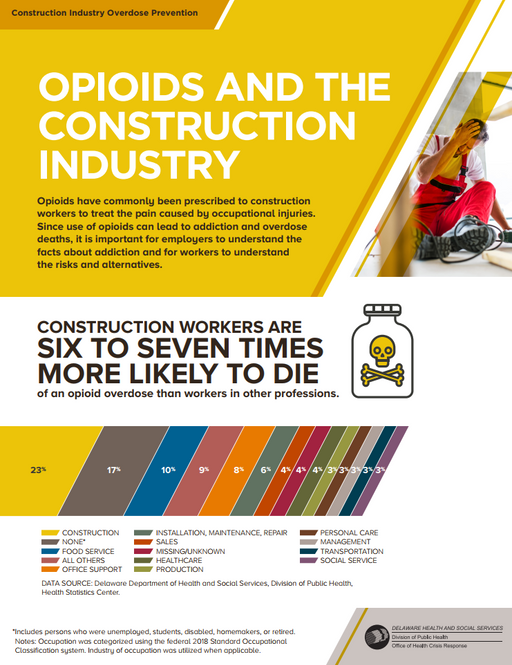
Opioids and the Construction Industry
- Data, resources, and reports about substance misuse in the construction industry
- Training programs available to employers
- How to reduce stigma on job sites and encourage treatment and recovery
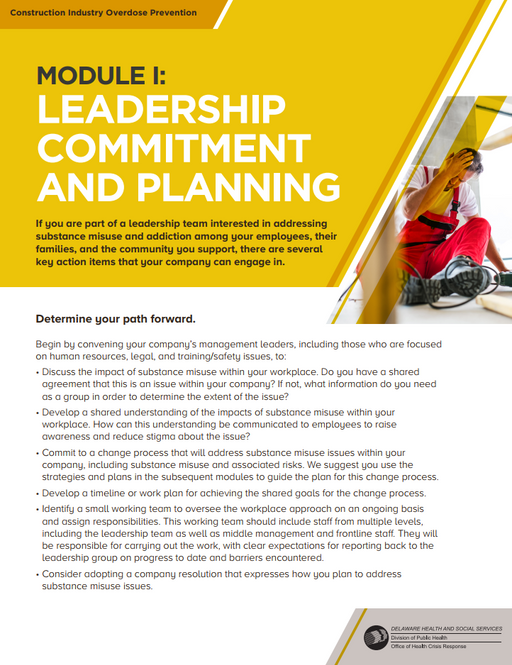
Module I: Leadership Commitment and Planning
- How to guide the plan
- Selecting a working team
- Agreeing on meeting frequency and key decision-makers
- Developing a company resolution
- Role-specific resources for human resources, safety professionals, supervisors, and employee education

Module II: Develop and Implement the Plan — Policies
- Convening a team and setting regular meetings
- Soliciting input
- Assessing current strategy effectiveness
- Determining training considerations and topics as well as who should be trained
- Understanding steps to take when drug misuse is identified
- Developing clearly written policies related to drug issues, including drug testing
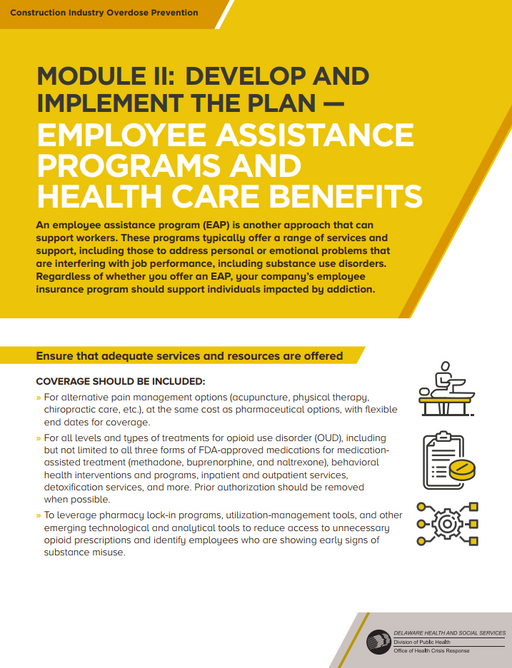
Module II: Develop and Implement the Plan — Employee Assistance Programs and Health Care Benefits
- Using employee assistance programs and health care benefits to support workers facing drug misuse challenges or risks
- Communicating to workers using awareness campaigns
- Initiating workplace naloxone training and access
- Using data to inform planning
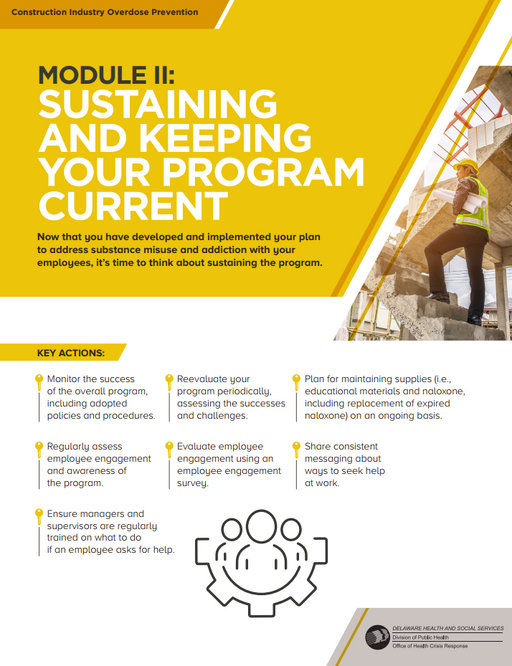
Module III: Sustaining and Keeping Your Program Current
- Determining success measurement
- Regularly assessing employee engagement and awareness
- Consistently sharing messages about what to do if workers need help with a drug-related issue
- Ensuring training of managers and supervisors on overdose education and naloxone
- Seeking or continuing to support community partnerships and resource development
- Using data to continue to inform support
- Connecting individuals to treatment and recovery support
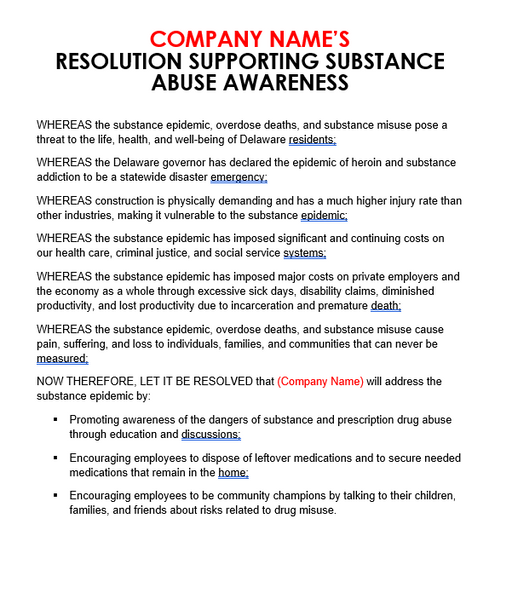
Customizable Employer Resolution Supporting Substance Abuse Awareness
- Sample language that will make it clear you support helping those facing the challenges of substance abuse — can be posted in employee and public areas
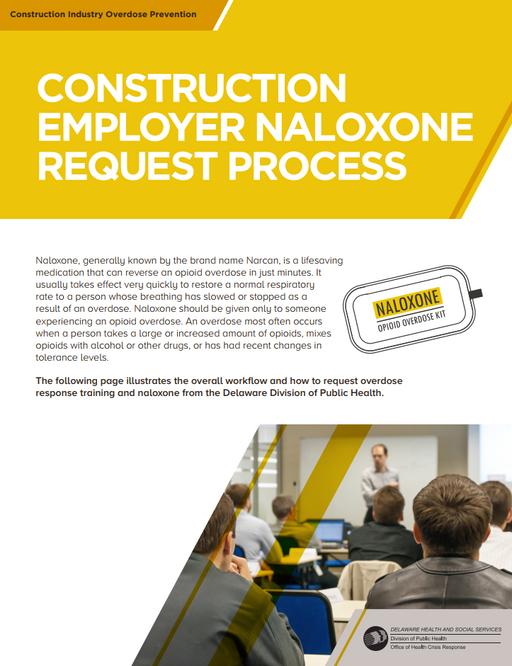
Construction Employer Naloxone Request
- How to request naloxone — overdose response medication — and training for your business

Construction Narcan Flyer
- Lifesaving information about Narcan — a medication that can stop an overdose while it is happening. Includes details about where to get Narcan and download info for the "How to Use" OpiRescue DE app.
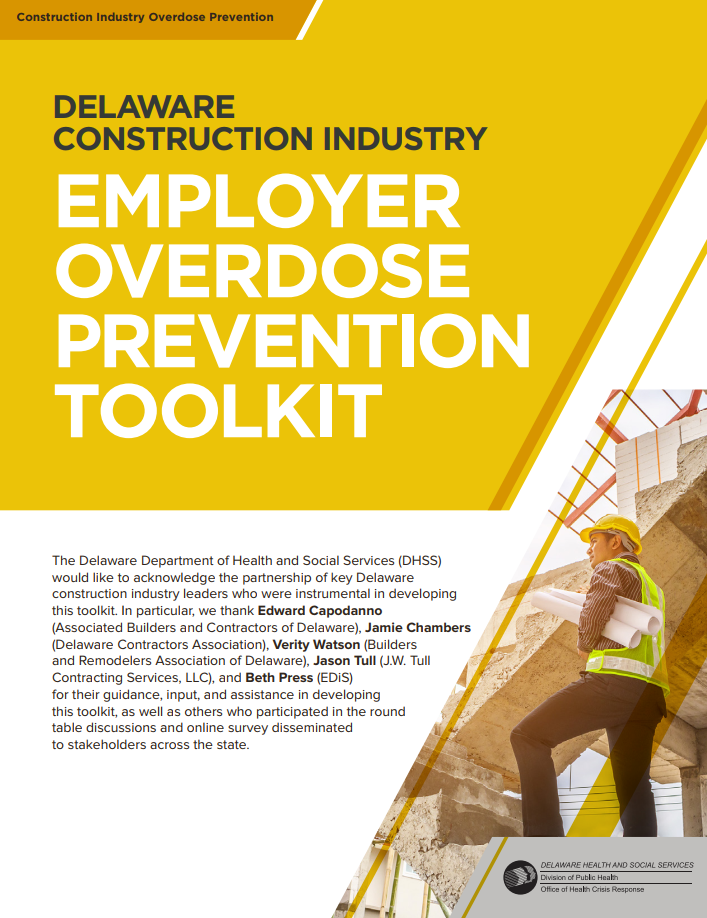
Download the Full 44-page Employer Overdose Construction Toolkit
Comprehensive details on each training module and complete data about opioid use and misuse in the construction industry.
Workplace communications keep the messaging going.
Internal communications play a key role in helping your employees know how to get help if they or someone they care about or work with is dealing with substance abuse. Posters, brochures, and even an app to offer directions on administering naloxone are available to use free of charge. You can download the construction-related print materials and view others at HelpIsHereDE.com.
Order free materialsMore support resources are a click away.
Information from several publicly available resources related to substances in the workplace can provide additional context for you as an employer, as well as for your employees and their families.
- The CPWR Center for Construction Research and Training Opioid Resources
- Blue Cross Blue Shield of Massachusetts Opioid Resource Center
- The Kentuckiana Health Collaborative Opioids and the Workplace Toolkit
- Pennsylvania’s Construction Employers Opioid Awareness Toolkit
- AGC MA’s Building the Pathway to Prevention
- The National Safety Council Opioids at Work Toolkit
- Substance Abuse and Mental Health Services Administration (SAMHSA) Treatment Locator
- SAMHSA’s National Helpline
- Naloxone/Narcan: Delaware Has a Standing Order for Naloxone
- Prescription Drug Employer Kit
- Substance Use Cost Calculator
- “Opioid: Warn Me” Labels
- Stop Everyday Killers Website
- Prescription Drug Abuse Epidemic: Painkillers Driving Addiction, Overdose
- Delaware Unused Medication Disposal Resources
- Annual National Prescription Drug Take-Back Days